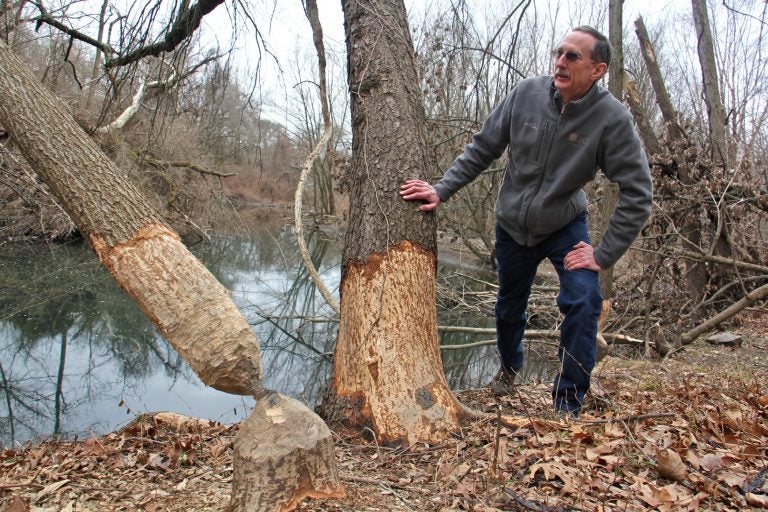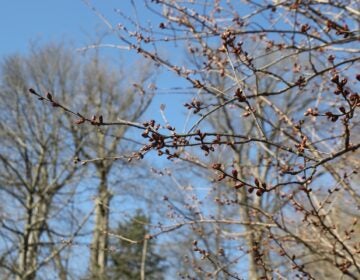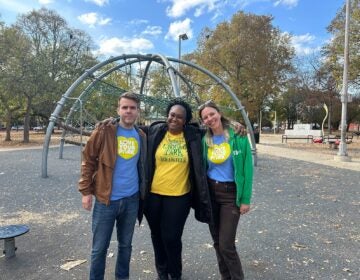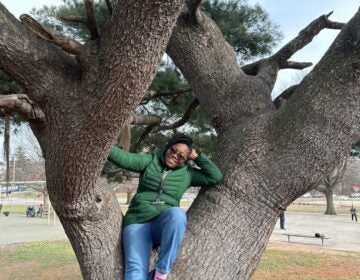Is there a beaver resurgence in Philadelphia?
Philadelphia Parks and Recreation reports beaver activity is on the rise but not a nuisance.
Listen 2:08
Tom Witmer, the Natural Lands Restoration manager for Philadelphia Parks & Recreation, checks out damage done by beavers along Cobbs Creek. (Emma Lee/WHYY)
Larry Lindsay and his wife took advantage of the warmer weather late Sunday afternoon with a walk in Philadelphia’s Fairmount Park. As he strolled along a metal boardwalk, some trees caught his attention.
“The trees that had been planted looked like they’d been cut off,” said Lindsay. “At first glance, I thought, who would do that? And then I saw that, in fact, they’d been chewed down.”
Lindsay and his wife then saw a beaver about the size of a little dog by a small lodge not far from the trees.
Lindsay called WHYY and left a voicemail about his sighting, not sure what to make of it or if it was newsworthy.
“Hope you can use it, maybe everybody knows about it already,” he said before hanging up.
It turns out Philadelphia Parks and Recreation didn’t know about it, and officials there know little about beaver activity in the city. Lindsay witnessed evidence of what could be a beaver resurgence — well, kind of.
We called Tom Witmer to learn more. He’s operations manager of Natural Lands Restoration, which is part of Philadelphia Parks and Recreation.
He took us to a section of Haddington Woods that is split by Cobbs Creek. The woods are so close to the 63rd Street Market Frankford Line train stop, you can see and hear trains pulling in. This section of woods has been the site of lots of beaver activity.
“So we’re now looking at a number of trees that are about 15 years old that have been felled recently by beavers,” said Witmer as we combed through the trees.
A black willow tree, a black cherry tree, some hickories and oaks have been totally cut down at their base — or are close to coming down.
“It takes a while for a tree that’s over a foot in diameter or so for a beaver to fell it,” said Witmer.
Witmer said there was almost no beaver activity 20 years ago in the city. But parks employees have seen more signs of beaver activity in the last decade — though it’s unclear just when it started.
According to Witmer, the department has put a lot of effort to restore wildlife in this stretch of Haddington Woods. The beaver activity is proof that their efforts are working.
“That’s partly due to both water quality and streamside vegetation improvements,” he said. “The challenging thing is too much of a good thing can sometimes not be a good thing. “
Witmer said beavers use tree bark for food and branches for their homes.
The beaver activity is not a nuisance yet, Witmer said, but the department decided to collect data on beaver activity late last year.
It’s recorded four instances of beaver activity so far.
If beavers start to claim too many trees, Witmer said his department would consider protecting trees with stump guards.
Still, at least one wildlife biologist said the beaver comeback is limited, in part because of all the urban and suburban development.
Sharon T. Brown has studied beavers for about 30 years, and she’s one of the founders of Beavers: Wetlands and Wildlife, an educational nonprofit.
She said taking a census of beavers is hard, but the highest estimates from experts put their U.S. population at 20 million, a fraction of their population before the fur trade and farming exploded.
“By no way are they surging somehow out of control, if the habitat no longer can support them, you know so many of our cities and towns are built around waterways,” said Brown.
Still, the WHYY listener who called about the beaver in Fairmount Park was happy to hear his beaver sighting was not a total anomaly.
“I’m delighted to hear there are other beavers in Cobbs Creek,” he said. “But I can understand how Parks and Recreation is concerned they might be destroying some of the new growth they’re trying to encourage.”
In our quest to learn about beavers in Philadelphia, we never spotted any ourselves. But Witmer said they become more active in spring.
WHYY is your source for fact-based, in-depth journalism and information. As a nonprofit organization, we rely on financial support from readers like you. Please give today.





